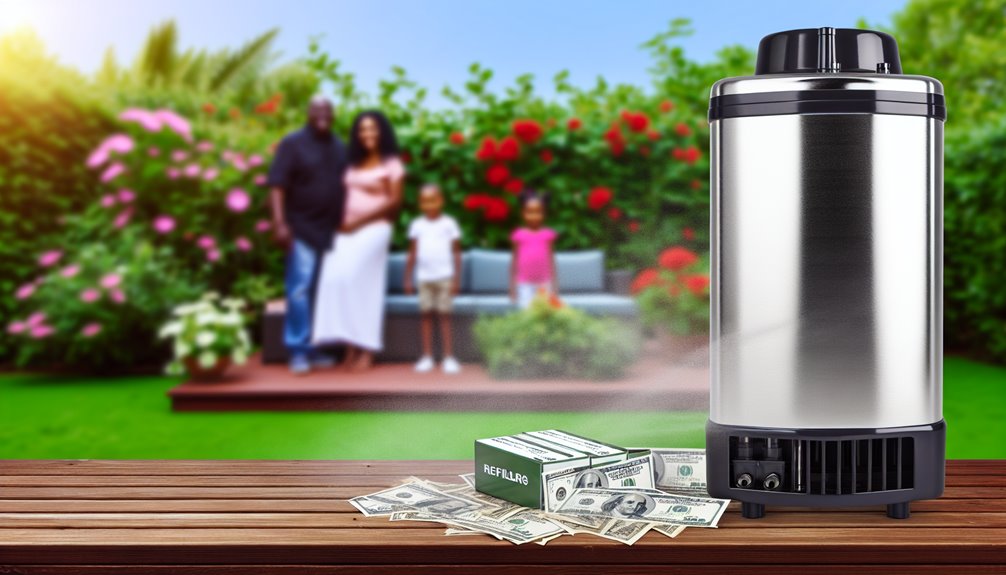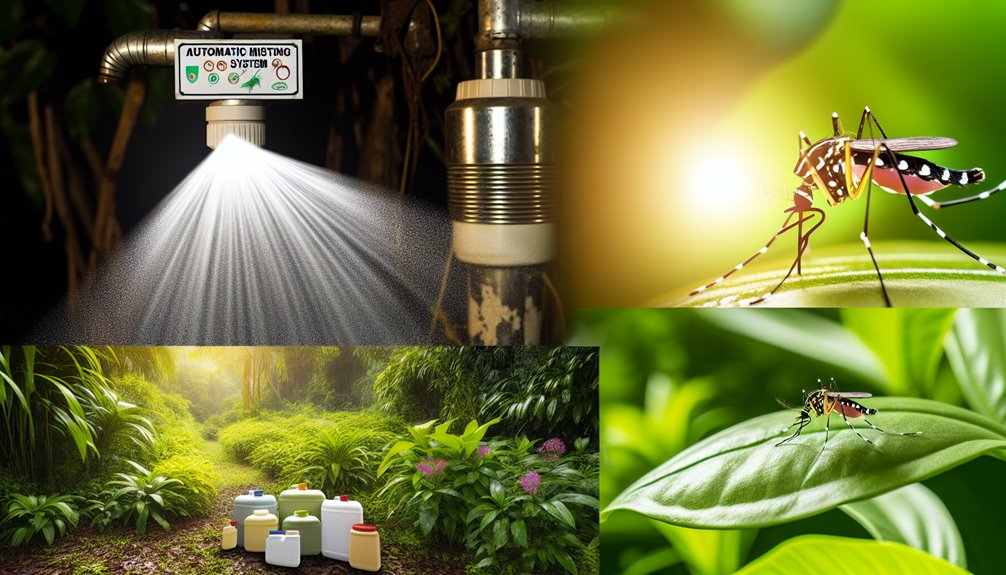In a Texas HOA trial, automated pyrethrin misting cut landing rates by ~70% over eight weeks, yet non-target captures dropped too. You’ll get consistent coverage in dense vegetation and at dusk when Aedes are active, but you’ll face high upfront costs, cartridge refills, and nozzle maintenance. Drift, resistance selection, and pollinator exposure are real risks without calibrated schedules and rotations. Before you invest, consider what the data say about long-term efficacy versus collateral impacts.
How Automatic Misting Systems Work

An automatic mosquito misting system meters a diluted insecticide through high‑pressure tubing to multiple nozzles, which atomize droplets (typically 10–50 microns) on a programmed schedule or via remote trigger. You’ll specify system components: reservoir, metering pump (often diaphragm), filtration, pressure regulator, solenoid valves, and stainless or nylon lines feeding nozzle orifices sized to deliver uniform flow. Misting technology relies on droplet spectra validated by ASTM E2798 methods to optimize surface interception and airborne suspension. Controllers log cycles, integrate wind/rain sensors, and support zone control. You’ll calibrate dosage (mg a.i./m3) and intervals, verify flow rates, and document maintenance.
Effectiveness Against Mosquitoes in Real-World Settings
Field performance hinges on coverage, droplet spectrum, and operational discipline: multi-site trials and residential studies report 60–90% reductions in adult landing counts when systems deliver 10–50 μm droplets at 0.5–1.5 mg a.i./m3, 2–4 cycles/day, and account for wind and obstructions. In practice, you’ll see real world effectiveness vary with perimeter nozzle placement, vegetation density, and competing light or CO2 sources. Field studies show strongest control within 5–7 meters of uniform plumes; gaps and dead zones degrade outcomes. Integrate larval source reduction and community education to sustain gains. Verify with weekly landing rates, ovitrap indices, and complaint logs.
Costs: Equipment, Installation, and Ongoing Refills

Budgets hinge on three buckets: hardware, install labor, and chemistry. You’ll face an initial investment for pumps, reservoir, tubing, and nozzles; system capacity (e.g., 30–90 nozzles) drives price. Professional installation adds trenching, electrical, and zoning controls; complex layouts increase labor hours. Chemistry costs depend on active ingredient, dilution rate (e.g., 0.03–0.1%), and seasonal spray frequency. Track long term costs by modeling runtime minutes, nozzle flow (mL/min), and refill price per liter. Add controller wear, nozzle replacements, and electricity (low but nonzero). Compare cost per protected square foot and per mosquito season to guarantee stewardship-oriented, data-backed budgeting.
Maintenance, Calibration, and Troubleshooting
Although these systems automate spraying, they still demand a tight maintenance and calibration routine to sustain efficacy and minimize waste. You’ll log nozzle flow rates (mL/min), verify droplet size (20–50 µm), and test pump pressure weekly. Seasonal system upkeep includes flushing lines, replacing clogged filters, and confirming timer accuracy against a calibrated stopwatch. Use leak checks and battery/load tests quarterly. When failures occur, apply structured troubleshooting tips: isolate components, measure voltage/pressure, and compare to specs.
- Verify uniform output: ±10% variance across nozzles
- Calibrate intervals to match habitat density and weather
- Document service metrics to predict part replacement cycles
Chemical Choices, Resistance, and Rotations

With hardware tuned and outputs verified, you need actives and formulations that deliver target droplet deposition and suppress vectors without accelerating resistance. Select EPA-registered adulticides with proven knockdown at 10–25 µm VMD. Use synergists judiciously; monitor label maximums. To slow chemical resistance, implement pesticide rotation across IRAC MoAs (e.g., 3A pyrethroids, 1B organophosphates, 22 fenoxycarb for IGR integration). Rotate by generation or 30–60 days, guided by surveillance data (trap counts, parity rates). Calibrate dose to achieve >90% mortality in bioassays while minimizing applications. Validate field performance with CDC bottle assays quarterly. Document treatments to refine rotations and sustain efficacy.
Impacts on Beneficial Insects, Pets, and the Environment
Even as you optimize droplet size and rotate modes of action, automatic misting systems can affect non-target organisms and environmental compartments in measurable ways. Field data show pyrethroids reduce beneficial insects—pollinators and natural enemies—when drift overlaps bloom or refugia. You can lower exposure by targeting crepuscular sprays and excluding flowering zones. For pet safety, acute toxicity is rare with label-compliant use, yet cats are sensitive to pyrethrins; secure nozzles, restrict access during sprays, and ventilate kennels. Environmental impact hinges on runoff and deposition; avoid spraying before rain, protect water features, and use low-volatility solvents.
- Protect pollinator foraging corridors
- Shield pet habitats
- Prevent runoff to waterways
Regulatory, Safety, and Neighborhood Considerations
Before you install or operate an automatic misting system, align it with federal, state, and local requirements that govern pesticide use, discharge, and notification. Verify product labels, EPA registration, setback rules, and permitting to confirm regulatory compliance. Document calibration logs, nozzle flow rates, and runtime schedules; audit annually. Implement safety protocols: lockable reservoirs, child-resistant caps, backflow prevention, wind-speed interlocks, leak detectors, and manual shutoffs. Train staff on PPE, first aid, and spill response; maintain SDS access. Build neighborhood agreements through transparent community engagement: share treatment schedules, active ingredients, and drift controls; offer opt-out zones. Track complaints and exposure incidents; report as required.
When Misting Makes Sense—and When It Doesn’t
If you need rapid, area-wide knockdown of adult mosquitoes during short, high-risk windows—such as peak arbovirus transmission or intense nuisance outbreaks—automatic misting can be justified, but routine, season-long use rarely pencils out. You’ll see the best benefits balancing when adult densities are high, outdoor use is predictable, and wind/temperature favor droplet deposition. Outside those windows, costs, resistance selection, and non-target impacts rise while returns fall. Calibrate nozzles, droplet size (10–30 µm), and timing to dusk/dawn activity. Track landing-rate counts and complaint data to guide triggers. Consider convenience factors, but let surveillance, epidemiology, and neighbor coordination drive decisions.
- Trigger by surveillance thresholds
- Align sprays with vector activity
- Document outcomes and adjust
Alternatives and Best Practices to Maximize Control
While misting can play a targeted role, you’ll maximize control by prioritizing integrated mosquito management that suppresses sources and interrupts life stages. Remove standing water weekly; scrub containers to dislodge eggs. Maintain gutters, irrigation, and drains to achieve 7–10 day dry-downs. Deploy larvicides (Bti, methoprene) per label to treat unavoidable water. Install tight screens and door sweeps; use fans to increase airspeed >2 m/s.
Combine EPA-registered natural repellents (oil of lemon eucalyptus) for personal protection with precise barrier treatments on vegetation where adults rest. Calibrate sprayers, rotate actives, and document efficacy via CDC light traps and landing-rate counts. Engage neighbors.
Conclusion
As the owner of Mosquito Eliminators of South MS, I genuinely believe in the power of effective mosquito control to enhance your outdoor experiences. While automatic misting systems can offer significant relief from pesky mosquitoes, it’s essential to consider all aspects, including costs and environmental impact. If you’re dealing with a high mosquito population, I encourage you to explore the best solutions tailored to your needs. We’re here to help you find a balanced approach that combines misting with other strategies for the best results. Feel free to visit us at mosquitoeliminatorsms.com or give us a call at (601) 336-2277. Together, we can create a more enjoyable outdoor space for you and your loved ones!

